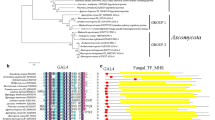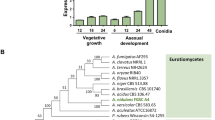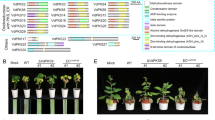Abstract
Chaetomium globosum is one of the most common fungi in nature. It is best known for producing chaetoglobosins; however, the molecular basis of chaetoglobosin biosynthesis is poorly understood in this fungus. In this study, we utilized RNA interference (RNAi) to characterize a polyketide synthase gene, pks-1, in C. globosum that is involved in the production of chaetoglobosin A. When pks-1 was knocked down by RNAi, the production of chaetoglobosin A dramatically decreased. Knock-down mutants also displayed a pigment-deficient phenotype. These results suggest that the two polyketides, melanin and chaetoglobosin, are likely to share common biosynthetic steps. Most importantly, we found that pks-1 also plays a critical role in sporulation. The silenced mutants of pks-1 lost the ability to produce spores. We propose that polyketides may modulate cellular development via an unidentified action. We also suggest that C. globosum pks-1 is unique because of its triple role in melanin formation, chaetoglobosin biosynthesis and sporulation. This work may shed light on chaetoglobosin biosynthesis and indicates a relationship between secondary metabolism and fungal morphogenesis.
Article PDF
Similar content being viewed by others
Avoid common mistakes on your manuscript.
References
Straus D C. The possible role of fungal contamination in sick building syndrome. Front Biosci (Elite Ed), 2011, 3: 562–580
Paterson P J, Seaton S, Yeghen T, et al. Molecular confirmation of invasive infection caused by Chaetomium globosum. J Clin Pathol, 2005, 58: 334
Inglis G D, Kawchuk L M. Comparative degradation of oomycete, ascomycete, and basidiomycete cell walls by mycoparasitic and biocontrol fungi. Can J Microbiol, 2002, 48: 60–70
Qi G, Lan N, Ma X, et al. Controlling Myzus persicae with recom-binant endophytic fungi chaetomium globosum expressing Pinellia ternata agglutinin: Using recombinant endophytic fungi to control aphids. J Appl Microbiol, 2011, 110: 1314–1322
Longoni P, Rodolfi M, Pantaleoni L, et al. Functional analysis of the degradation of cellulosic substrates by a chaetomium globosum endophytic isolate. Appl Environ Microbiol, 2012, 78: 3693–3705
Fogle M R, Douglas D R, Jumper C A, et al. Growth and mycotoxin production by chaetomium globosum. Mycopathologia, 2007, 164: 49–56
Sutton D A, Slifkin M, Yakulis R, et al. U.S. case report of cerebral phaeohyphomycosis caused by Ramichloridium obovoideum (R. mackenziei): Criteria for identification, therapy, and review of other known dematiaceous neurotropic taxa. J Clin Microbiol, 1998, 36: 708–715
Kapoor N, Tyagi M, Kumar H, et al. Production of cellulose enzyme by Chaetomium sp. using wheat straw in solid state fermentation. Res J Microbio, 2010, 5: 1199–1206
Qin J C, Zhang Y M, Gao J M, et al. Bioactive metabolites produced by Chaetomium globosum, an endophytic fungus isolated from Ginkgo biloba. Bioorg Med Chem Lett, 2009, 19: 1572–1574
Natori S, Yahara I, eds. Cytochalasins in Mycotoxins and Phytoalexins. Boca Raton: CRC Press, 1991
Umeda M, Ohtsubo K, Saito M, et al. Cytotoxicity of new cyto-chalasans from Chaetomium globosum. Experientia, 1975, 31: 435–438
Ohtsubo K, Saito M, Sekita S, et al. Acute toxic effects of chaetoglobosin A, a new cytochalasan compound produced by Chaetomium globosum, on mice and rats. Jpn J Exp Med, 1978, 48: 105–110
Jiao W, Feng Y, Blunt J W, et al. Chaetoglobosins Q, R, and T, three further new metabolites from Chaetomium globosum. J Nat Prod, 2004, 67: 1722–1725
Probst A, Tamm C. 19-O-acetylchaetoglobosin B and 19-O-acetylchae-toglobosin D, two new metabolites of Chaetomium globosum. Helv Chim Acta, 1981, 64: 2065–2077
Scherlach K, Boettger D, Remme N, et al. The chemistry and biology of cytochalasans. Nat Prod Rep, 2010, 27: 869–886
Brakhage A A, Schuemann J, Bergmann S, et al. Activation of fungal silent gene clusters: A new avenue to drug discovery. Prog Drug Res, 2008, 66:1, 3–12
Georgianna D R, Payne G A. Genetic regulation of aflatoxin biosynthesis: From gene to genome. Fungal Genet Biol, 2009, 46: 113–125
Yang G, Rose M S, Turgeon B G, et al. A polyketide synthase is required for fungal virulence and production of the polyketide T-toxin. The Plant cell, 1996, 8: 2139–2150
Wu D, Oide S, Zhang N, et al. ChLae1 and ChVel1 regulate T-toxin production, virulence, oxidative stress response, and development of the maize pathogen Cochliobolus heterostrophus. PLoS Pathog, 8: e1002542
Kennedy J, Auclair K, Kendrew S G, et al. Modulation of polyketide synthase activity by accessory proteins during lovastatin biosynthesis. Science, 1999, 284: 1368–1372
Abe Y, Suzuki T, Ono C, et al. Molecular cloning and characterization of an ML-236B (compactin) biosynthetic gene cluster in Penicillium citrinum. Mol Genet Genomics, 2002, 267: 636–646
Zhang A, Lu P, Dahl-Roshak A M, et al. Efficient disruption of a polyketide synthase gene (pks1) required for melanin synthesis through Agrobacterium-mediated transformation of Glarea lozoyensis. Mol Genet Genomics, 2003, 268: 645–655
Bok J W, Balajee S A, Marr K A, et al. LaeA, a regulator of morphogenetic fungal virulence factors. Eukaryot Cell, 2005, 4: 1574–1582
Bok J W, Keller N P. LaeA, a regulator of secondary metabolism in Aspergillus spp. Eukaryot Cell, 2004, 3: 527–535
Bayram O, Krappmann S, Ni M, et al. VelB/VeA/LaeA complex coordinates light signal with fungal development and secondary metabolism. Science, 2008, 320: 1504–1506
Nakayashiki H. RNA silencing in fungi: mechanisms and applications. FEBS Lett, 2005, 579: 5950–5957
Nakayashiki H, Hanada S, Nguyen B Q, et al. RNA silencing as a tool for exploring gene function in ascomycete fungi. Fungal Genet Biol, 2005, 42: 275–283
Salame T M, Ziv C, Hadar Y, et al. RNAi as a potential tool for biotechnological applications in fungi. Appl Microbio Biot, 2011, 89: 501–512
Janbon G, Maeng S, Yang D H, et al. Characterizing the role of RNA silencing components in Cryptococcus neoformans. Fungal Genet Biol, 2010, 47: 1070–1080
Moriwaki A, Katsube H, Ueno M, et al. Cloning and characterization of the BLR2, the homologue of the blue-light regulator of Neurospora crassa WC-2, in the phytopathogenic fungus Bipolaris oryzae. Curr Microbiol, 2008, 56: 115–121
McDonald T, Brown D, Keller N P, et al. RNA silencing of mycotoxin production in Aspergillus and Fusarium species. Mol Plant Microbe In, 2005, 18: 539–545
Leng Y, Wu C, Liu Z, et al. RNA-mediated gene silencing in the cereal fungal pathogen Cochliobolus sativus. Mol Plant Pathol, 2011, 12: 289–298
Engh I, Nowrousian M, Kück U. Regulation of melanin biosynthesis via the dihydroxynaphthalene pathway is dependent on sexual development in the ascomycete Sordaria macrospora. FEMS Microbiol Lett, 2007, 275: 62–70
Moriwaki A, Kihara J, Kobayashi T, et al. Insertional mutagenesis and characterization of a polyketide synthase gene (pks1) required for melanin biosynthesis in Bipolaris oryzae. FEMS Microbiol Lett, 2004, 238: 1–8
Takano Y, Kubo Y, Shimizu K, et al. Structural analysis of pks1, a polyketide synthase gene involved in melanin biosynthesis in Colletotrichum lagenarium. Mol Gen Genet, 1995, 249: 162–167
Turgeon B G, Garber R C, Yoder O C. Development of a fungal transformation system based on selection of sequences with promoter activity. Mol Cell Biol, 1987, 7: 3297–3305
Raeder U, Broda P. Rapid preparation of DNA from filamentous fungi. Lett Appl Microbiol, 1985, 1: 17–20
Livak K J, Schmittgen T D. Analysis of relative gene expression data using real-time quantitative PCR and the 2(-Delta Delta C(T)) Method. Methods, 2001, 25: 402–408
Anand S, Prasad M V, Yadav G, et al. Sbspks: Structure based sequence analysis of polyketide synthases. Nucleic Acids Res, 2010, 38: W487–496
Hopwood D A, Sherman D H. Molecular genetics of polyketides and its comparison to fatty acid biosynthesis. Annu Rev Genet, 1990, 24: 37–66
Schumann J, Hertweck C. Molecular basis of cytochalasan biosynthesis in fungi: gene cluster analysis and evidence for the involvement of a PKS-NRPS hybrid synthase by RNA silencing. J Am Chem Soc, 2007, 129: 9564–9565
Brakhage A A, Schroeckh V. Fungal secondary metabolites-strategies to activate silent gene clusters. Fungal Genet Biol, 2011, 48: 15–22
Wheeler M H, Bell A A. Melanins and their importance in pathogenic fungi. Curr Top Med Mycol, 1988, 2: 338–387
Chang S S, Zhang Z, Liu Y. RNA interference pathways in fungi: Mechanisms and functions. Annu Rev Microbiol, 2012, 66: 305–323
Tanguay P, Bozza S, Breuil C. Assessing RNAi frequency and efficiency in Ophiostoma floccosum and O. piceae. Fungal Genet Biol, 2006, 43: 804–812
Liu H, Cottrell T R, Pierini L M, et al. RNA interference in the pathogenic fungus Cryptococcus neoformans. Genetics, 2002, 160: 463–470
Feng B, Wang X, Hauser M, et al. Molecular cloning and charac-terization of WdPKS1, a gene involved in dihydroxynaphthalene melanin biosynthesis and virulence in Wangiella (Exophiala) dermatitidis. Infect Immun, 2001, 69: 1781–1794
Takano Y, Kubo Y, Shimizu K, et al. Structural analysis of PKS1, a polyketide synthase gene involved in melanin biosynthesis in Colletotrichum lagenarium. Mol Gen Genet, 1995, 249: 162–167
Calvo A M, Wilson R A, Bok J W, et al. Relationship between secondary metabolism and fungal development. Microbiol Mol Biol Rev, 2002, 66: 447–459
Grosse C, Heinekamp T, Kniemeyer O, et al. Protein kinase A regulates growth, sporulation, and pigment formation in Aspergillus fumigatus. Appl Environ Microbiol, 2008, 74: 4923–4933
Shimizu K, Keller N P. Genetic involvement of a cAMP-dependent protein kinase in a G protein signaling pathway regulating morphological and chemical transitions in Aspergillus nidulans. Genetics, 2001, 157: 591–600
Takano Y, Kikuchi T, Kubo Y, et al. The Colletotrichum lagenarium MAP kinase gene CMK1 regulates diverse aspects of fungal pathogenesis. Mol Plant Microbe Interact, 2000, 13: 374–383
Kawamura C, Tsujimoto T, Tsuge T. Targeted disruption of a melanin biosynthesis gene affects conidial development and UV tolerance in the Japanese pear pathotype of Alternaria alternata. Mol Plant Microbe Interact, 1999, 12: 59–63
Wolf J C, Mirocha C J. Regulation of sexual reproduction in Gibberella zeae (Fusarium roxeum “graminearum”) by F-2 (Zearalenone). Can J Microbiol, 1973, 19: 725–734
Schimmel T G, Coffman A D, Parsons S J. Effect of butyrolactone I on the producing fungus, Aspergillus terreus. Appl Environ Microbiol, 1998, 64: 3707–3712
Zhou R, Rasooly R, Linz J E. Isolation and analysis of fluP, a gene associated with hyphal growth and sporulation in Aspergillus parasiticus. Mol Gen Genet, 2000, 264: 514–520
Author information
Authors and Affiliations
Corresponding author
Additional information
This article is published with open access at Springerlink.com
Rights and permissions
Open Access This article is distributed under the terms of the Creative Commons Attribution 2.0 International License (https://creativecommons.org/licenses/by/2.0), which permits unrestricted use, distribution, and reproduction in any medium, provided the original work is properly cited.
About this article
Cite this article
Hu, Y., Hao, X., Lou, J. et al. A PKS gene, pks-1, is involved in chaetoglobosin biosynthesis, pigmentation and sporulation in Chaetomium globosum. Sci. China Life Sci. 55, 1100–1108 (2012). https://doi.org/10.1007/s11427-012-4409-5
Received:
Accepted:
Published:
Issue Date:
DOI: https://doi.org/10.1007/s11427-012-4409-5




